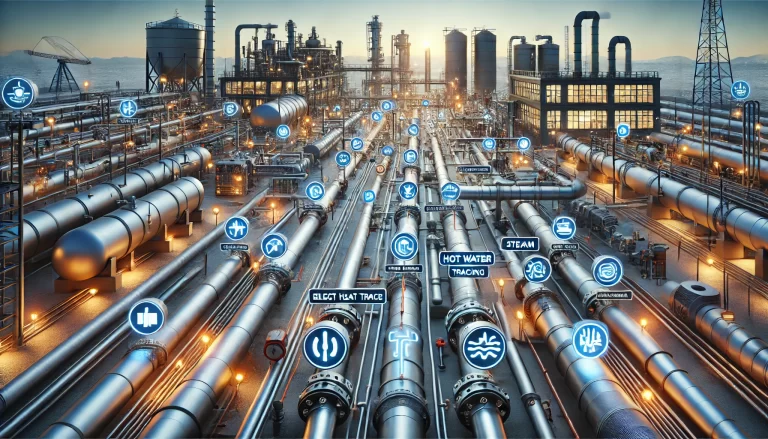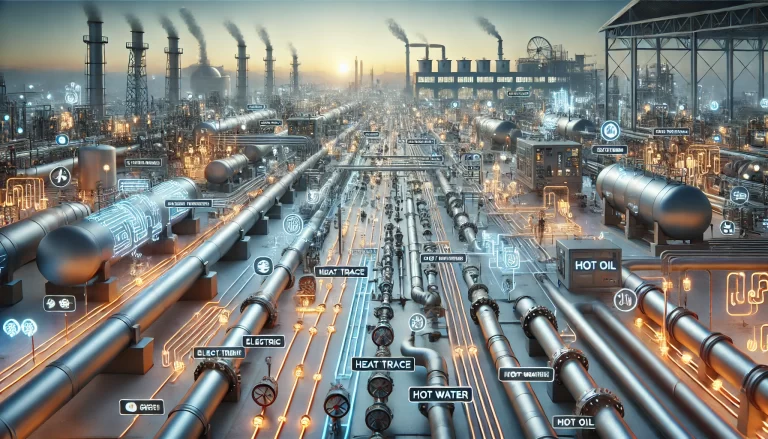In various industries, pipeline heating, or “tracing,” plays a critical role in maintaining the flow and stability of substances transported through pipelines. It prevents materials from freezing, solidifying, or deteriorating during transfer, making it especially valuable in fields such as petrochemicals, natural gas, chemical production, food processing, and pharmaceuticals. This article explores the primary types of pipeline heating methods, each suited to different environmental and operational needs, and discusses their specific benefits and applications.
Why Pipeline Heating Matters in Industrial Production
In many industries, liquid and semi-liquid materials, such as oils, chemicals, or food products, must remain at specific temperatures to maintain their fluidity and quality. In cold environments, these materials may freeze or solidify, causing pipeline blockages that disrupt production and necessitate costly maintenance. Pipeline heating systems address this problem by stabilizing pipeline temperatures, ensuring a smooth flow and preventing costly downtimes. The benefits of using pipeline heating in industrial applications include:
- Preventing Freezing and Blockages: By keeping pipelines warm, heating systems ensure that materials do not freeze or clog.
- Maintaining Fluid Flow: Certain materials, like wax or crude oil, have poor fluidity at lower temperatures and require stable heating to maintain flow.
- Saving Energy and Reducing Maintenance Costs: Unlike traditional insulation methods, pipeline heating provides precise temperature control, reducing energy consumption and extending pipeline life.
- Enhancing Product Quality: In industries where temperature consistency is essential, like pharmaceuticals and chemicals, pipeline heating helps maintain the quality of transported materials.
- Supporting Automation and Smart Control: Modern heating systems often incorporate sensors and automated temperature control, making them efficient and reducing the need for manual intervention.
- Adaptability to Harsh Environments: Pipeline heating systems are designed to perform in corrosive, humid, or dusty environments, making them suitable for various industrial applications.

Types of Pipeline Heating Methods
Each pipeline heating method has unique characteristics suited to specific industrial needs. Here’s a detailed look at the most common types:
1. Electric Heat Tracing (EHT)
Electric heat tracing involves using electric heating cables, commonly called “heat trace cables,” to generate heat through electrical resistance. This heat is then transferred to the pipeline. Electric heat tracing is widely used in mid-sized and small pipelines and offers a variety of cable types:
- Self-Regulating Heat Trace Cables: These adjust heat output based on ambient temperature, making them energy-efficient and reducing the risk of overheating.
- Constant Wattage Cables: These provide a uniform heat output and are ideal for applications requiring consistent temperatures.
- Parallel Circuit Cables: These cables allow for longer lengths and are better suited for extensive heating requirements.
Advantages: Electric heat tracing offers precise temperature control, is easy to install, and has low maintenance costs, making it ideal for short-distance and mid-sized pipelines.
Disadvantages: The system depends heavily on electrical power, which can lead to high operating costs in large-scale applications. Electric tracing may also create electromagnetic interference in sensitive environments.
2. Steam Tracing
Steam tracing relies on steam to heat pipelines, making it especially suitable for high-temperature environments such as oil refineries and chemical plants. Steam is routed through a separate pipeline that transfers heat to the target pipeline, maintaining the desired temperature.
Advantages: Steam tracing is highly effective for large-scale applications requiring high temperatures, and it’s an economical choice in facilities with existing steam infrastructure.
Disadvantages: The system can be challenging to maintain due to potential corrosion issues and leaks. It also requires access to a reliable steam source and careful insulation to ensure efficiency.
3. Hot Water Tracing
Hot water tracing uses hot water, rather than steam, as a heat source. This method is typically used for low- to moderate-temperature applications, such as in food processing or pharmaceutical production.
Advantages: Hot water tracing is relatively easy to control and provides a stable temperature, making it suitable for processes where overheating is a concern.
Disadvantages: Its heating capabilities are limited to lower temperatures, and the system is generally less effective for long-distance or high-temperature requirements.
4. Hot Oil Tracing
In hot oil tracing, heated oil is circulated around pipelines to maintain temperatures in mid- to high-temperature environments. This method is often used for processes requiring stable, high-temperature heat transfer, such as in petrochemical and chemical production.
Advantages: Hot oil can maintain consistent high temperatures, providing stable heating and reducing the risk of freezing.
Disadvantages: The system requires careful setup and maintenance due to the complexity of the oil circuit. Selecting the right oil is crucial, and operating costs can be higher compared to other methods.
5. Infrared Tracing
Infrared tracing uses infrared heaters that emit heat directly onto the pipeline surface. This method is typically employed for targeted, localized heating of pipeline sections or specific equipment.
Advantages: Infrared tracing doesn’t require a heat transfer medium, providing fast and efficient heat. It’s ideal for localized heating and applications where minimal space is available.
Disadvantages: Infrared heating is only effective in small areas and is not well-suited to long pipeline sections.

6. Hot Air Tracing
Hot air tracing involves blowing heated air over the pipeline or through an insulated enclosure surrounding the pipeline. This technique is suitable for environments where pipeline surfaces need moderate heating and uniform temperature distribution.
Advantages: Hot air tracing provides even heating and allows for temperature control, making it suitable for unique equipment or irregularly shaped pipelines.
Disadvantages: This method is less energy-efficient and is generally ineffective for high-temperature applications or extensive pipelines.
7. Chemical Tracing
Chemical tracing relies on exothermic chemical reactions to generate heat and is used in extreme environments where other methods may be challenging to implement, such as in remote or off-grid locations.
Advantages: Chemical tracing does not require an external power source, making it suitable for temporary heating or emergency situations.
Disadvantages: It’s challenging to control and typically used only in specialized applications due to its operational complexity and cost.
Choosing the Right Heating Method
Selecting a pipeline heating method depends on various factors, including:
- Temperature Requirements: Determine the desired temperature range for materials in transit.
- Environmental Conditions: Consider external temperature, humidity, and potential exposure to corrosive substances.
- Economic Factors: Evaluate both the initial setup costs and long-term operational expenses.
- Safety Considerations: Industries such as oil and gas prioritize safety, making reliable and fail-safe systems essential.
- Automation and Control Needs: Modern pipeline heating systems often integrate sensors and automated controls to regulate temperature in real time.
Conclusion
Pipeline heating systems offer a versatile and reliable solution for maintaining the fluidity and quality of materials in industrial pipelines. With various methods available, each suited to specific operational needs, industries can benefit from selecting the most appropriate solution to ensure efficiency, safety, and cost-effectiveness. From electric tracing for precise control to steam and hot oil tracing for high-temperature applications, these systems continue to play a vital role in keeping industries running smoothly and productively.
